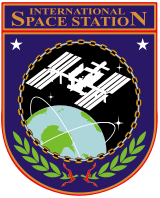Harmony (ISS module)
Harmony, also known as Node 2, is the "utility hub" of the International Space Station. It connects the laboratory modules of the United States, Europe and Japan, as well as providing electrical power and electronic data. Sleeping cabins for four of the crew are housed here.[3]
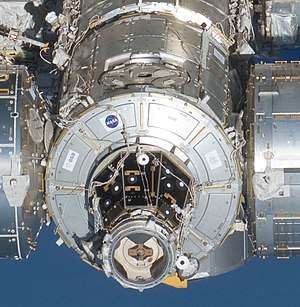 Harmony shown connected to Columbus, Kibo, and Destiny. PMA-2 faces towards the camera. The nadir and zenith locations are open. | |
| Module statistics | |
|---|---|
| Launch date | 23 October 2007 |
| Launch vehicle | Space Shuttle Discovery |
| Docked | 26 October 2007 |
| Mass | 14,500 kilograms (32,000 lb) |
| Length | 6.706 metres (22.00 ft) |
| Diameter | 4.480 metres (14.70 ft) |
| Pressurised volume | 70 cubic metres (2,500 cu ft) |
| References: [1][2] | |
Harmony was successfully launched into space aboard Space Shuttle flight STS-120 on October 23, 2007.[4][5] After temporarily being attached to the port side of the Unity node,[6][7] it was moved to its permanent location on the forward end of the Destiny laboratory on November 14, 2007.[8] Harmony added 2,666 cubic feet (75.5 m3) to the station's living volume, an increase of almost 20 percent, from 15,000 cu ft (420 m3) to 17,666 cu ft (500.2 m3). Its successful installation meant that from NASA's perspective, the station was considered to be "U.S. Core Complete".
Origin of name
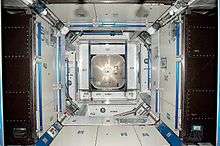
The unit formerly known as Node 2 was renamed Harmony in March 2007.[9] The name was chosen from a competition involving more than 2,200 kindergarten through high school students from 32 US states.[1][10] The Node 2 Challenge required students to learn about the space station, build a scale model, and write an essay explaining their proposed name for the module, which will serve as a central hub for science labs. The winning class was from Browne Academy.
Specifications


Harmony is the second of three node modules on the United States Orbital Segment (USOS).[1] It is composed of a cylindrical, 2219-T851 aluminium alloy pressure shell with two endcones and is thermally insulated by a goldised Kapton blanket. It is protected from micrometeoroids by 98 panels, each made from a composite sandwich of stainless steel and 6061-T6 aluminium alloy, and a secondary barrier of Kevlar/resin.[11][12] The design is based on the existing Multi-Purpose Logistics Module, as well as the European Space Agency's Columbus module (both of which have only one passive Common Berthing Mechanism [CBM]).[1] There are six CBMs on Harmony: the aft CBM that connects it to Destiny is passive; the rest are active.[13]
Harmony is managed by NASA's Marshall Space Flight Center in Huntsville, Alabama. Its deployment expanded the Space Station, allowing it to grow from the size of a three-bedroom house, to the space equivalent of a typical five-bedroom house, once the Japanese Kibō and European Columbus laboratories are attached. The Space Station robotic arm, Canadarm2, is able to operate from a powered grapple fixture on the exterior of Harmony.[14] Harmony is equipped with eight International Standard Payload Racks: four avionics racks and four for stowage or crew quarters.[12] After the cancellation of the Habitation Module, Harmony was chosen to house the American Crew Quarters.[15][16] The first two were delivered on STS-126 and the second two on STS-128.[17][18]
Construction agreement
In an agreement between NASA and the European Space Agency the Italian France-based company Thales Alenia Space built Harmony at its facility in Turin, Italy.[14] Harmony arrived on June 1, 2003 at the Kennedy Space Center in Florida after its flight in an Airbus Beluga oversize cargo vehicle. Following post transportation inspection, the Italian Space Agency formally handed over Harmony to the European Space Agency (ESA). From there, ESA formally transferred ownership of Harmony to NASA on June 18, 2003, taking place in the Space Station Processing Facility of the Kennedy Space Center.[19] The handover of Harmony completed a major element of the barter agreement, between ESA and NASA, that was signed in Turin on October 8, 1997.[19]
Paolo A. Nespoli, an ESA astronaut born in Milan, Italy, accompanied the Harmony module aboard STS-120 as a mission specialist.
Launch
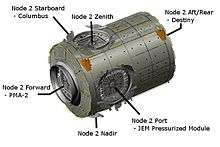
Harmony was launched October 23, 2007 aboard STS-120, as the primary component of assembly mission ISS-10A.[20][21][22]
On October 26, the station's Space Station Remote Manipulator System (SSRMS) removed Harmony from the shuttle cargo bay and temporarily mated it to the port side of Unity and, on October 27, the crew entered Harmony.[6][23] After the Space Shuttle departed Harmony was relocated to the forward dock of the Destiny laboratory. It required three EVAs by the station crew to complete the installation.[23][24]
Connecting modules and visiting vehicles

Harmony was the first permanent living space enlargement to the ISS after the Pirs docking compartment was added in 2001. The Expedition 16 crew moved the Pressurized Mating Adapter (PMA-2) on November 12, 2007 from Destiny to the forward berth of Harmony. The combined PMA-2/Harmony unit was subsequently berthed to its final destination at the forward end of Destiny on November 14, 2007.[8] All the following Space Shuttle missions would dock at this location.
On February 11, 2008, ESA's Columbus laboratory was attached to the starboard hatch of the Harmony module during space shuttle mission STS-122. On March 14, 2008 the Experiment Logistics Module Pressurized Section (ELM-PS) of Kibō was attached to its interim location: the zenith hatch of Harmony. During STS-124 a Space Shuttle mission flown by Space Shuttle Discovery, the Pressurized Module of Kibō was added to the port side of Harmony and the ELM-PS was moved, leaving the zenith hatch empty. The zenith hatch was originally intended to be the permanent docking connector for the now canceled Centrifuge Accommodations Module (CAM).
When the Space Shuttle flew the Multi-Purpose Logistics Modules (MPLMs) to the station, the MPLM would be temporarily berthed to the nadir mechanism of Harmony.[25] The Japanese H-II Transfer Vehicle and the American Commercial Resupply Service vehicles, Dragon and Cygnus, are temporarily berthed to either the nadir or zenith mechanism.
In August 2016, the forward docking port was equipped with the international docking adapter delivered with the CRS-9 mission. This adapter was used for the first time for the automatic docking of the Crew Dragon spacecraft during its uncrewed test mission on March 3, 2019.[26]
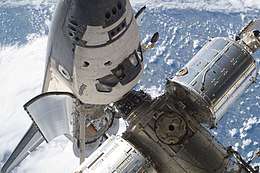 Space Shuttle docked to PMA-2
Space Shuttle docked to PMA-2 MPLM berthed to Node 2 nadir
MPLM berthed to Node 2 nadir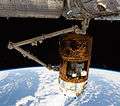 HTV being berthed to Node 2 nadir
HTV being berthed to Node 2 nadir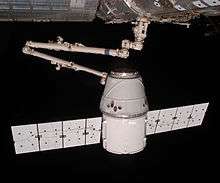 Dragon being berthed to Node 2 nadir
Dragon being berthed to Node 2 nadir Cygnus being unberthed from Node 2 nadir
Cygnus being unberthed from Node 2 nadir Canadarm2 moving the Harmony module into position on the ISS
Canadarm2 moving the Harmony module into position on the ISS
On March 26, 2017 PMA-3 was robotically removed from the Tranquility module and attached to the zenith port of the Harmony module after being prepared during a successful spacewalk on March 24, 2017. A second spacewalk was conducted on March 30, 2017 to finalize the PMA-3 cable connections on Harmony. PMA-3 is linked to the International Docking Adapter-3 adapter, delivered on the SpaceX CRS-18 mission in July 2019.[27] IDA-3 was fully linked to PMA-3 during an EVA on 21 August 2019.[28]
References
- European Space Agency (2007). "Node 2: Connecting Module". ESA. Retrieved January 23, 2020.
- NASA. "Harmony Node". NASA. Retrieved January 23, 2020.
- Williams, Suni (presenter) (May 19, 2013). Station Tour: Harmony, Tranquility, Unity (video). NASA. Event occurs at 0.06-0.35. Retrieved August 31, 2019.
So this is Node 2 ... this is where four out of six of us sleep.
- NASA (October 23, 2007). "STS-120 MCC Status Report #01". NASA.
- John Johnson Jr. (October 24, 2007). "Space Shuttle Discovery lifts off". Los Angeles Times. Retrieved October 23, 2007.
- William Harwood (2007). "Harmony module pulled from cargo bay". CBS News. Retrieved October 26, 2007.
- John Schwartz (October 26, 2007). "New Room Added to Space Station". The New York Times. Retrieved October 26, 2007.
- NASA (2007). "PMA-3 Relocation". NASA. Retrieved September 28, 2007.
- NASA (2007). "NASA Space Station Module In Perfect 'Harmony' With New Name". National Aeronautics and Space Administration. Retrieved September 28, 2007.
- Tariq Malik (2007). "Students Name Next U.S. Space Station Module 'Harmony'". SPACE.com. Retrieved September 28, 2007.
- "STS-120 Press Kit" (PDF). NASA. October 2007. p. 33. Retrieved January 23, 2020.
- "Node-2 Harmony Factsheet" (PDF). ESA. pp. 4–5. Retrieved January 23, 2020.
- "ISS Interface Mechanisms and their Heritage" (PDF). NASA. p. 23. Retrieved November 4, 2011.
- NASA (2007). "Space Station Assembly: Harmony Node 2". NASA. Retrieved September 28, 2007.
- "At Home with Commander Scott Kelly (Video)". International Space Station: NASA. December 6, 2010. Retrieved May 8, 2011.
- James Lee Broyan, Melissa Ann Borrego, and Juergen F. Bahr (2008). "International Space Station USOS Crew Quarters Development" (PDF). SAE International. Retrieved May 8, 2011.CS1 maint: uses authors parameter (link)
- "STS-126 Press Kit" (PDF). NASA. November 2008. Retrieved September 26, 2011.
- "STS-128 Press Kit" (PDF). NASA. August 2009. Retrieved September 26, 2011.
- European Space Agency. (2003). "European Node officially handed to NASA". ESA. Retrieved September 28, 2007.
- NASA (2007). "STS-120 to Deliver Harmony Node to ISS". NASA. Retrieved September 28, 2007.
- NASA (2007). "STS-120 Bringing Space Station 'Harmony'". NASA. Retrieved September 28, 2007.
- NASA (2007). "Launch Schedule: Consolidated Launch Manifest". NASA. Retrieved September 28, 2007.
- William Harwood for CBS News (2007). "Astronauts enter Harmony". Spaceflight Now. Retrieved October 27, 2007.
- Victor Amateur Radio Association (2007). "Upcoming Shuttle Missions and ARISS Operations". Victor Amateur Radio Association. Retrieved September 28, 2007.
- SpaceRef.com (2007). "Space Station User's Guide: ISS Elements: Node 2". SpaceRef.com. Retrieved September 28, 2007.
- "NASA, SpaceX Launch First Flight Test of Space System Designed for Crew". Nasa.gov. NASA. Retrieved March 2, 2019.
- Gebhardt, Chris (July 27, 2019). "CRS-18 Dragon arrives at the ISS following Falcon 9 launch". Retrieved June 9, 2020.
- Bergin, Chris; Harding, Pete (August 21, 2019). "EVA-55 installs second IDA to allow for additional commercial crew vehicle options". Retrieved June 9, 2020.
External links
| Wikimedia Commons has media related to Harmony (module). |
